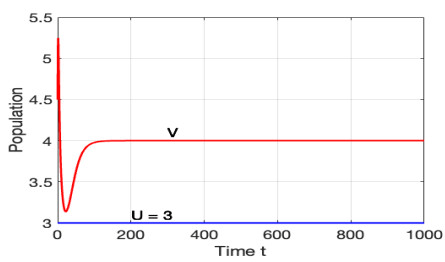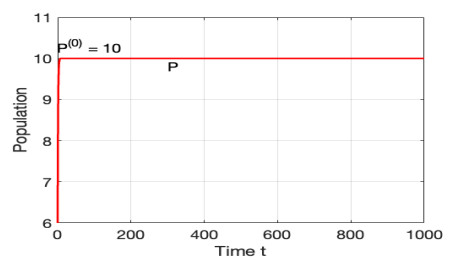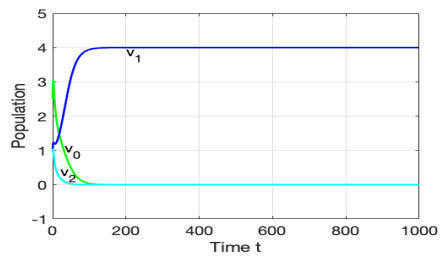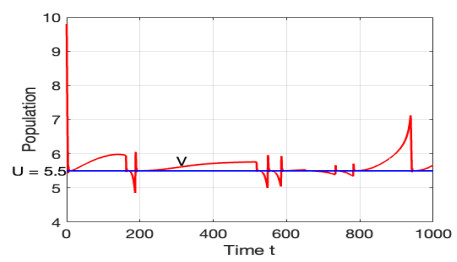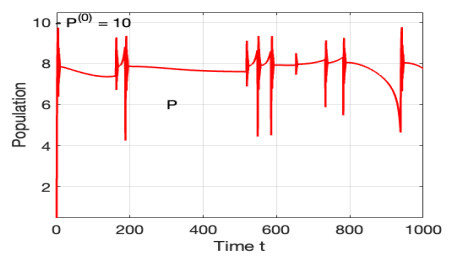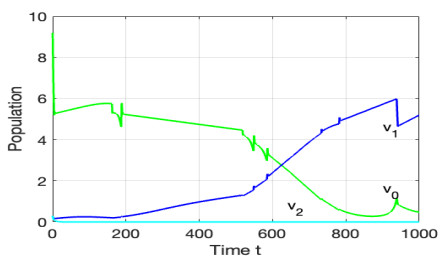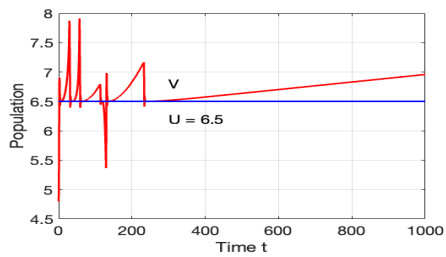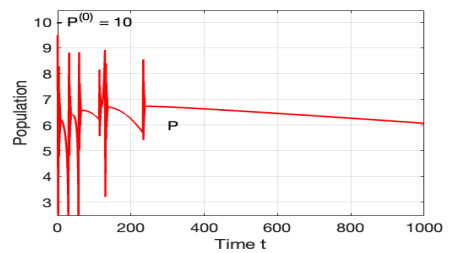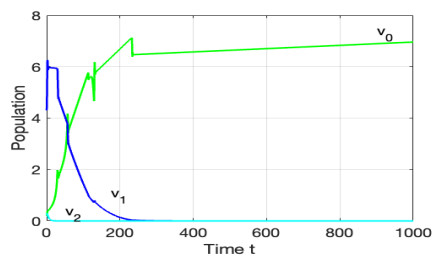1.
Introduction and models
1.1. Introduction
Antibiotic drug resistance is a global health problem [9]. Five years after the clinical application of penicillin, staphylococcus aureus with penicillin resistance [8] was found in humans, which caused penicillin to fail in some patients. These years, human beings may face the dilemma of infecting multiple drug-resistant bacteria (commonly known as superbugs) without any help of antibiotics because of the antibiotic drug resistance.
In [10,11] the authors presented a devices for building and operating an automated fluid system for continuous culture called "morbidostat" (See Figure 1.1). The morbidostat is used to study evolution of mircobial drug resistance in real time, It constantly measure the growth rates of evoluting mircobial populations inside culture in order to maintain a constant drug-induced inhibition. The growth rate measurements are done by using an optical detection system. Similar to chemostat rate D lower than the maximal growth rate of population in morbidostat. In contrast to a chemostat in which the bacterial growth in inherently the cell density is kept low such that the population in not nutrient limited, its growth rate is also controlled by externally adjusting drug concentration.
In this work, we follow the same mathematical model of morbidostat in [5,6]. When the total population of all bacteria are less than a threshold value U, there is no drug injection into the morbidostat and dPdt=−DP. However if the total population of all bacteria reaches over the threshold value U, there will be continuous drug injection into morbidostat. The growth rate of species i will be gi(S)fi(P) where S is the concentration of nutrient, gi(S) takes the form of Holling type Ⅱ gi(S)=miSai+S and P is the concentration of drug, the inhibition fi(P) takes the form of Hill function fi(P)=11+(PKi)L and dPdt=D(P(0)−P).
Remark: We note that in [5,6], we assume
i.e, the n-th mutant has largest growth rate.
In [6] we consider periodic resetting for nutrient and drug; while in [5] we consider drug on-drug off mechanism.
In this paper we relax the assumption (H∗) with drug on-drug off dynamics in the morbidostat.
1.2. Description of the models
In this work, we analyze the transition between the population of wild type u and those of mutant vi (i=1.2,⋯,n). Consider the drug on-drug off model with forward mutations(see Figure 1.2) and forward-backward mutations(see Figure 1.3).
The growth dynamics with the nutrient substrate S in a chemostat under the influence of the drug inhibitor P with forward mutations and forward-backward mutations are given by (1) and (2) respectively:
where i=1,2,3,⋯,n−1. Let v0=u and vi are the volume densities of the wild type and mutant populations, respectively. γ denotes the yield constant, reflecting the conversion of nutrient to bacteria. S is the concentration of nutrient, while S(0) is the input concentration of nutrient. D is the dilution rate. g0(S) and gi(S) are the growth rates of the wild type and mutants, which satisfy gi(0)=0, g′i(S)>0 for i=0,1,2,⋯,n. It implies that bacteria grows only when there has nutrient substrate in the device, and a higher concentration of nutrient leads to the bacteria's higher growth rates. Here we consider the important special case gi(S)=miSai+S. qi denotes the forward mutation from vi to vi+1, and ~qi is the backward mutation from vi+1 to vi. qi and ~qi are small positive quantities. Besides, the drug inhibitions for vi are described by fi(P) for i=0,1,2,⋯,n. It is easy to know, the higher concentration of drug leads to a stronger inhibition to the growth of bacteria. Based on the fact that mutants always have stronger resistances to the inhibitor than wild-type, and the i-th mutant vi has stronger resistances than the (i−1)-th mutant vi−1. So we assume
for i=0,1,2,⋯,n.
Let gi(λi)=D, i.e. λi=ai(miD−1). We also assume that:
which implies the wild type u which has smallest break-even concentration, is the most superior species than the mutants vi in the absence of drug inhibition [1].
The rest of this paper is organized as follows. In Section 2 we study the dynamics of drug on-drug off models with no mutations, In Section 3 we study the dynamics of drug on-drug off models with forward mutations. In Section 4 we study the dynamics of drug on-drug off models with forward-backward mutations. Section 5 is a section of numerical simulations for various threshold parameters U. Section 6 is the discussion section.
2.
Dynamics of drug on-drug off model with no mutations
Without loss of generality by scaling, we assume the yield constant, γ=1.
Lemma 2.1. (Conservation Property) S(t)+∑ni=0vi(t)→S(0) as t→∞.
Proof. Let M(t)=S(t)+∑ni=0vi(t).
Adding the first n+2 equations of (1) and (2), yields
So M(t)=S(t)+∑ni=0vi(t)→S(0) as t→∞. □
For simplicity in (1) we assume that qi=0 for all i=0,1,2,⋯,n. Let u=v0, the system (1) becomes
Next we state two theorems which will be used in Section 2.1 below.
Theorem A (Competitive exclusion in simple chemostat) ([1] p. 30 or p. 35)
Consider the simple chemostat equation
with S(0)≥0 and vi(0)>0. Let (H2) hold. Then
□
Consider two systems of ordinary differential equations of the form
and
where
We assume A is an m×m matrix, f is continuous differentiable, D is positively invariant for (F.1) and (F.2) is dissipative. Let (B1)-(B5) be additional hypothesis:
(B1) All of eigenvalues of A have negative real parts.
(B2) Equation (F.2) has finite number of rest points in Ω, each of which is hyperbolic ([2], p. 88) for (F.2). Denote these rest points by x1,…,xp.
(B3) The dimension of the stable manifold {([2], p. 88)} is n for 1≤i≤r, and the dimension of the stable manifold of xj is less than n for j=r+1,…,p. In symbols, dim(M+(xj))=n,i=1,…,r; dim(M+(xj))<n for j=r+1,…,p.
(B4) Ω=∪pi=1M+(xj).
(B5) Equation (F.2) does not possess a cycle of rest points.
Theorem B (A convergence theorem)([1], p. 294)
Let (B1)-(B5) hold and (y(t),z(t)) be a solution of (F.1). Then, for some i,
2.1. The behavior of solutions of the system (3)
For the solution of the system (3), we discuss the following three cases:
Case 1 : ∑ni=0vi(t)<U for all t>t0>0 for some t0>0. Then we have
it is obvious that
Let
Then by Lemma 2.1, we have
and Σ1(t)→0 and Σ2(t)→0 as t→∞. Rewrite the system (3) with dPdt=−DP as
The system corresponding to (F.2) in Theorem B is
Apply Theorem B with A=diag(−D,−D),m=2 and
Under the hypothesis (H2), we apply Theorem A and obtain a result of global stability,
Now we verify the hypothesis (B1)-(B5) holds for the systems (2.1) and (2.2). Obviously the 2×2 matrix A satisfies hypothesis (B1). For hypothesises (B2), (B3), (B4), equation (2.2) has finite number of rest points in Ω, namely, O=(0,0,…,0), E0=(v∗0,0,…,0), Ei=(0,…,v∗i,…,0), v∗i=S(0)−λi,i=1,2,…,n. dim(M+(E0))=n+1, dim(M+(Ei))=n−(i−1),i=1,2,…,n. To verify the cyclic condition (B5), we note that from (H2) Ej is chained to Ei, Ej→Ei,j>i,i,j=0,1,2,…,n if and only if λj<λi and Ei→O for all i=1,2,…,n. Suppose there is a cycle in Ω, Ek(1)→Ek(2)→⋯→Ek(1) then it follows that λk(1)<λk(2)<⋯<λk(1) which is obviously a contradiction to (H2)
Case 2 : ∑ni=0vi(t)≥U for all t>t0>0 for some t0≥0. Then we have
we have
Let
Then we have
and Σ1(t)→0 and Σ2(t)→0 as t→∞. Rewrite the system (3) with dPdt=(P(0)−P),
The system corresponding to (F.2) in Theorem B is
We may verify the hypothesises (B1)-(B5) as in the Case 1.
If mifi(P(0))≤D, then it is easy to show limt→∞vi(t)=0. Thus we assume that
Replace mi in gi(S) by mifi(P(0)), we have a new simple chemostat equation.
Let
then
as t→∞ or
Case 3 : ∑ni=0vi<U at some sequence {tk}, tk→∞ and ∑ni=0vi≥U at some other sequence {tl}, tl→∞,k=1.2.⋯, l=1,2,⋯, k≠l, ∑ni=0vi oscillates around U.
2.2. The results of the asymptotic behavior of the solutions of model with no mutations
Lemma 2.2. Let vi,i=0,…,n be the solution of system (2.4). Let (H1), (H2), (H3) hold, then ^v∗k<v∗0.
Proof. Since
and 0<fi(P(0))<1, then ^λk>λk.
Obviously, we obtain
Hence,
□
In the following Theorem 2.3 we shall give sufficient conditions for the Case 1, Case 2 and Case 3 for the solutions of the system (3).
Theorem 2.3. Let (H1), (H2), (H3) hold and vi,i=0,1,…,n be the solutions of the system (3), then
(I) if U>v∗0, then there exists t0>0, such that for all t≥t0, ∑ni=0vi(t)<U. From Case 1 in section 2.1, limt→∞S(t)=λ0, limt→∞u(t)=S(0)−λ0, limt=→∞vi(t)=0, i=1,2,…,n.
(II) Let ^λl=max0≤i≤nˆλi and ^v∗l=S(0)−^λl<^v∗k. If U<^v∗l, then there exists t0>0, such that for all t≥t0, ∑ni=0vi(t)≥U. From Case 2 in section 2.1, limt→∞S(t)=^λk, limt→∞vk(t)=^v∗k=S(0)−^λk, limt→∞vi(t)=0,i≠k,i=0,1,2,…,n.
(III) if ^v∗k<U<v∗0, then ∑ni=0vi(tk)≥U for some {tk}, tk→∞ and ∑ni=0vi(tl)<U for some other sequence {tl}, tl→∞. This is Case 3 in section 2.1, ∑ni=0vi(t) oscillates around U.
Proof.
1. We shall exclude the following two cases:
(i) ∑ni=0vi(t)≥U for all t>0.
From Case 2 in section 2.1, we have vk→^v∗k, vi→0, where i≠k.
So ∑ni=0vi→^v∗k<U as t→∞. By Lemma 2.2 ∑ni=1vi(t)→^v∗0<v∗0<U a contradiction to ∑ni=0vi(t)≥U for all t≥0.
(ii) There exists ˆt>0, such that
In this case, consider the system (2.1),
we obtain that
It follows that S(0)−∑ni=1vi(ˆt)=S(0)−U<λ0<λ1<⋯<λn,
gi(S(0)−∑ni=0vi(ˆt))<gi(λi) for all i=0,1,…,n.
Hence ddt(∑ni=0vi)|t=ˆt<0.
This is a contradiction to (2.6).
Hence, we exclude (i) and (ii). It follows that ∑ni=0vi<U for t≥t0 for some t0>0.
2. We shall exclude the following two cases:
(i) ∑ni=0vi(t)≤U for all t>0.
In this case, we have v0→v∗0, vi→0, where i≠k.
So ∑ni=0vi→v∗0>U as t→∞. Since U<^v∗l<^v∗k<v∗0, we obtain a contradiction to ∑ni=0vi(t)≤U for all t>0
(ii) There exists ˉt>0, such that
In this case, we consider the system (3),
we obtain that
Let
When U≤^v∗l, ∑ni=0vi(ˉt)=U≤^v∗l=S(0)−^λl
It follows that S(0)−∑ni=0vi(ˉt)≥^λl>^λi, i=0,1,⋯,n and i≠l
The monotonicity of gi(S) implies that gi(S(0)−∑vi)≥gi(^λi), from (2.8)
This is a contradiction to (2.7)
Hence ∑ni=0vi(t)≥U for all t large.
3. Assume ˆv∗k<U<^v∗0, ∑ni=0vi≥U for all t>0.
Then from (H3) and (2.6), vk→^v∗k, vi→0, where i≠k.
So ∑ni=0vi→^v∗k<U as t→∞, a contradiction to the assumption ∑ni=0vi≥U for all t large.
Suppose ∑ni=0vi<U for t large.
Then from (H2) v0⟶v∗0, vi⟶0, i=1,2,⋯,n, as t→∞.
So ∑ni=0vi⟶v∗0>U as t→∞, a contradiction.
Hence ∑ni=0vi oscillates around U.
□
Remark 2.4. When ^v∗l≤U<^v∗k, from the numerical studies in section 5, we conjecture that the conclusion in (Ⅱ) in Theorem 2.3 holds, i.e. limt→∞S(t)=^λk, limt→∞^vk(t)=^v∗k=S(0)−^λk, limt→∞vi(t)=0 for i≠k, i=0,1,…,n.
Remark 2.5. When the threshold value U satisfies ˆv∗k<U<ˆv∗0, we conjecture that the competitive exclusion principle holds. In this case, we conjecture that there exist a bifurcation point U∗ such that for ˆv∗k<U<U∗, species vk wins the competition; for U∗<U<v∗0 the wild type species u:=v0 wins the competition. We note that from (Ⅲ) of Theorem 2.3 for ˆv∗k<U<ˆv∗0, ∑ni=0vi oscillates around U. Thus the solution of the system (3) will not tend to equilibrium E0=(λ0,ˆv∗0,0,…,0) or E1=(ˆλ0,0,…,0,ˆv∗k,0,…,0). See Figure 5.3 (a), 5.3 (b), 5.3 (c) and Figure 5.4(a), 5.4(b), 5.4(c) in Section 5.
3.
Dynamics of drug on-drug off model with forward mutations
Consider the following drug on-drug off model with forward mutation:
3.1. The behavior of the solutions of the system (1)
As we did in Section 2, we discuss three cases.
Case 1 : ∑ni=0vi(t)<U for all t>t0 for some t0>0. Then we have
It is obvious that
As we did in case 1 in Section 2.1, it suffices to consider the limiting system of (1)
Theorem 3.1. Let q=(q0,q1,⋯,qn), then (3.1) has a unique positive equilibrium E(q)=(v∗0(q),⋯,v∗n(q)) satisfying
Proof. Consider the first equation of (3.1) :
Then the positive equilibrium, v0=v∗0(q)>0, satisfies
The monotocity of g0(S) implies that S∗=g−10(D+q0) is unique.
Since q0 is close to 0, we have S∗ is close to g−10(D)=λ0.
Let S∗=λ0+ϵ, ϵ>0 is small enough.
From (H2), it follows that gi(S∗)=gi(λ0+ϵ)<gi(λi)=D, i=1,2,…,n−1.
Then we have for i=1,2,…,n−1,
Consider the n+1 equations in (3.2), we denote them in the form of Ax=y as following,
Let A(0) =
We apply the following elementary transformations on A(0).
(Step 1) Consider the (n+1)-th row in A(0), multiplying g0(S∗)q0 to 1st row and subtracting it from (n+1)-th row, and we have
A(1)=
where m1=g1(S∗)−g0(S∗)q0⋅(g1(S∗)−D−q1)
Since g1(S∗)>0, g0(S∗)>0, q0>0, we have m1>0.
After n elementary transformations, we get an upper triangular matrix
A(n)=
So the solution (v∗0,v∗1,v∗2,⋯,v∗n) exists and is unique.
By mathematical induction, we can show that, mn in A(n) is positive.
From (3.4), we have
and it follows that v∗n>0
From (3.2), we obtain
For each 1≤i≤n−1,
Hence v∗i>0 for all 0≤i≤n.
and the equilibrium E(q)=(v∗0(q),v∗1(q),v∗2(q),⋯,v∗n(q)) is positive.
□
Since q≈0, E(q) is closed to E0, so we use the following perturbation theory to discuss the local and global stability of E(q).
Theorem 3.2. [4] Let A,B∈Cn×n, with A simple. If A has eigenvalues λ1,λ2,⋯,λn and μ is an eigenvalue of A+B, and if for a matrix norm induced by an absolute vector norm ‖‖v, we have r=‖B‖‖A‖v, then μ lies in at least one of the disks z:|z−λj|≤r, j=1,2,⋯,n, of the complex z-plane.
Theorem 3.3. [7] Assume that (x0,λ0)∈U×Λ, x0∈IntU, f(x0,λ0)=0, all eigenvalues of Dxf(x0,λ0) have negative real part, and x0 is globally attracting for solutions of x′=f(x,λ) with λ=λ0. If there exists a compact set D⊂U such that for each λ∈Λ and each z∈U, x(t,z,λ)∈D for all large t, then there exists ϵ>0, and a unique point ^x(λ)∈U for λ∈BΛ(λ0,ϵ) such that f(ˆx(λ),λ)=0 and x(t,z,λ)⟶ˆx(λ) as t⟶∞ for all z∈U.
Theorem 3.4. E(q) is locally stable.
Proof. From (2.2) in Section 2, E0 is a stable equilibrium where E0=(v∗0,0,…,0),v∗0=S(0)−λ0. The Jacobi matrix of system (2.2) evaluated at E0, is
The eigenvalues μ0,μ2,⋯,μn+1 of J(E0) are μ0=−v∗0g′0(λ0)<0,μ1=g1(λ0)−D<0,…,μn=gn(λ0)−D<0.
From (3.2), we have the Jacobi matrix of system (3.1) evaluated at E(q),
J(E(q))=
Since qi is sufficiently small,
we have gi(S∗)≈gi(λ0) and g′i(S∗)≈g′i(λ0).
Let J(E(q))=J(E0)+B, then |B|≈0.
From Theorem 3.2, the eigenvalues of J(E(q)) lies in at least one of the disks z:|z−μi|≤ϵ,i=0,1,⋯,n (ϵ is small enough).
Since μi<0 for all i=0,1,⋯,n, all eigenvalues of J(E(q)) have negative real part.
Hence E(q) is locally stable. □
Theorem 3.5. E(q) is globally stable.
Proof. Write (3.2) as dxdt=f(x,q), when x=(S,u,v1,⋯,vn) and q=(q0,q1,⋯,qn−1).
Take U=R+∪Bϵ(E0), and Λ(q)=[0,δ]n−1.
when q=0, i.e. all the qi=0 for each 0≤i≤n, f(E0,0)=0, and Dxf(E0,0) has all negative eigenvalues.
Take D=[0,S(0)]n+2, then D is compact.
when qi≈0, and x=E(q), we have f(E(q),q)=0.
By Theorem 3.3, x(t,z,q)→E(q) as t→∞ for all z∈U.
This concludes that E(q) is globally stable. □
Next we discuss Case 2.
Case 2 : ∑ni=0vi(t)≥U for all t>t0 for some t0>0.
Then
and hence
As we did in Case 2 in Section 2.1, it suffice to consider the limiting system of (1)
We shall study (3.7) by using the same method for the system (2.4) in section 2.1,
Suppose (H3) holds, let
Theorem 3.6.
1. System (3.7) has an equilibrium E∗=(v0∗,⋯,vn∗).
(i) If ^λ0=min0≤i≤nˆλi, then vi∗>0 for all i=0,1,⋯,n. Write E∗=(¯v0,¯v1,⋯,¯vn) satisfying
(ii) If ^λk=min0≤i≤nˆλi for some k, 0<k<n, then vi∗=0 for i=0,1,⋯,k−1 and vj∗>0 for k≤j≤n. Write E∗=(0,⋯,~vk,⋯,~vn) satisfying
(iii) If ^λn=min0≤i≤nˆλi, then vi∗=0 for all i=0,1,⋯,n−1 and vn∗>0. Write E∗=(0,0,⋯,0,vn∗), vn∗=S(0)−ˆλn.
2. For the system (3.7), E∗ is global stable. \end{enumerate}
Proof.
1.
(i) Since ˆλ0<ˆλi,i=1,2,…,n, replacing gi(S) by fi(P(0))gi(S) in Theorem 3.1, we complete the proof of (i).
(ii) Consider the steady state of the first equation in (3.7),
Claim: v∗0 = 0
if not, v∗0>0 then g0(S∗)f0(P(0))−D−q0=0. Since the mutation rate qi,i=0,1,…,n are sufficiently small, g0(S∗)≈g0(^λk).
This leads to a contradiction g0(S∗)f0(P(0))−D−q0=0. Hence we have v∗0=0.
Similarly from the steady state equation of (3.7)
we obtain vi∗=0,i=1,2,…,k−1. Thus E∗=(0,…,0,ˆvk,…,ˆvn) satisfies (3.9).
Consider the n−k+1 equations in (3.9), we denote them in the form of Ax=y as following,
Since qk is close to 0, we have ˜S is close to g−1k(Dfk(P(0)))=^λk.
Let ˜S=^λk+ϵ, ϵ is small enough,
From (H2), get gi(˜S)fi(P(0))=gi(^λk+ϵ)fi(P(0))<gi(^λi)fi(P(0))=D.
It follows that gi(˜S)fi(P(0))−D−qi<0, and gn(˜S)−D<0.
Use the same method as Theorem 3.1, we have ˜vi>0 when k≤i≤n.
(iii) Particularly, when ^λn=min0≤i≤nˆλi,
Let gn(S)fn(P(0))−D=0, we can get S=^λn.
Similarly, we can use mathematical induction as the second part of Theorem 3.6 to prove that vi∗=0 for all 0≤i≤n−1, and then vn∗=S(0)−λn.
2. Since qi is small enough and close to 0, E∗ is close to E1.
We can also use the perturbation theory (Theorem 3.2 and Theorem 3.3) to prove the local and global stability of E∗. The proof is similar to Theorem 3.4 and Theorem 3.5.
□
Case 3 :
If ∑ni=0vi(tk)<U at some sequence {tk}, tk→∞ and ∑ni=0vi(tl)≥U at some other sequence {tl}, tl→∞, k=1.2.⋯, l=1,2,⋯, k≠l, ∑ni=0vi oscillates around U.
3.2. The results of the asymptotic behavior of the solutions of model with forward mutations
From Lemma 2.1, we have S(t)+∑ni=0vi(t)⟶S(0) as t→∞.
In case 1, S(t)→S∗=g−10(D+q0), which is close to λ0.
So ∑ni=0vi(t) is close to S(0)−λ0 (=v∗0) as t→∞.
In case 2, S→S∗=g−1k(D+qk), which is approximately equal to ^λk, but a little greater than ^λk.
So ∑ni=0vi(t) is close to S(0)−^λk (=^v∗k) as t→∞.
By the theory of perturbation, we can get the same relation between ∑ni=0vi and U as Theorem 2.3 in Section 2.
Theorem 3.7. Let (H1), (H2), (H3) hold, then
(I) if U>v∗0, then there exists t0, such that for all t≥t0, ∑ni=0vi(t)<U
(II) Let ^λl=max0≤i≤nˆλi and ^v∗l=S(0)−^λl<^v∗k. If U<^v∗l, then there exists t0>0, such that for all t≥t0, ∑ni=0vi(t)≥U.
(III) if ^v∗k<U<v∗0, then ∑ni=0vi(tk)≥U for some sequence {tk}, tk→∞ and ∑ni=0vi(tl)<U for some other sequence {tl}, tl→∞.
Proof.
(I) Assume U>v∗0, we shall exclude the following two cases.
(i) ∑ni=0vi(t)≥U for t>0. Then P(t)→P(0) as t→∞. Consider the limiting system (3.7). By perturbation method in Theorem 3.3 and the result in Case 2 of section 2.1, we have
where i≠k, c1(q) and ci(q) are small, q=(q1,…,qn). Then
and it follows that
This is a contradiction to the assumption (i):
(ii) There exists ˆt>0 such that
From the system (1),
It follows that
Hence
This is a contradiction. Excluding (i) and (ii), we obtain ∑ni=0vi<U for t large.
(II) Assume U<ˆv∗l. Then ∑ni=0vi(t)≥U for t≥t0. Applying the perturbation method and the method in Theorem 2.3 (Ⅱ), we finish the proof of (Ⅱ).
(III) Assume v∗k<U<v∗0. Suppose ∑ni=0vi≥U for t large. Then by perturbation method in Theorem 3.3 and the results in Case 2 of section 2.1,
a contradiction.
Suppose ∑ni=0vi<U for t large. Then
Hence ∑vi→v∗0+c0(q)+∑ni=1ci(q)>U, a contradiction.
Hence ∑ni=0vi oscillates around U.
□
4.
Dynamics of drug on-drug off model with forward-backward mutations
Consider the model
Lemma 4.1. ([3], p. 141) If y(t) has a finite limit as t→∞ and y(n) is bounded for t≥t0, then y(k)(t)→0 as t→∞ for 0<k<n.
In this section we only consider Case 1 and Case 2, i.e. we assume either U>v∗0 or U<ˆv∗l. Then the solutions of (2) are smooth.
Lemma 4.2. In (2), if vm(t)→0 as t→∞ for some m, 0≤m≤n, then we can get vk(t)→0 as t→∞, for all k≠m and 0≤k≤n.That means all the species will go extinction as long as one of them goes extinction when time is long enough. Otherwise, all species coexists.
Proof. We just prove the cases when 0<m<n, since m=0 and m=n are similar.
Consider the model (2), we have
From Lemma 2.1, we have
and 0<S≤S(0) and 0<P≤P(0).
From the first equation in (2),
For 1≤i≤n−1,
from (4.2),
it is easy to see that |v′i|, |P′|≤DP(0), |S′|, |f′m(P)|, |g′m(S)| are bounded.
It follows from (4.1), we conclude that |d2vmdt2| is bounded.
Since vm→0 as t→∞, and |d2vmdt2| is bounded.
From Lemma 4.1, we have dvmdt→0 as t→∞.
It implies that qm−1vm−1+~qmvm+1→0 as t→∞, vm−1→0, vm+1→0 as t→∞.
Hence vk→0 as t→∞ for k≠m. □
From Lemma 4.2, there are two cases: Either all the bacteria vi (0≤i≤n) go extinction or all of them coexist. In the drug on-drug off model with forward-backward mutations, we get the next results.
Theorem 4.3. Let the hypothesis (H1) and (H2) hold and vi (0≤i≤n) be the solutions of system (2), then the species vi (0≤i≤n) coexists.
Proof. If all the species vi (i=0,1,⋯,n) go extinction, then ∑ni=0vi→0<U as t→∞.
We have
Consider the second equation of the system (2):
Since g0(S(0))−D=g0(S(0))−g0(λ0)>0 and qi, ~qi are sufficiently small.
dudt>0 as t→∞, which contradicts to u→0 as t→∞.
Hence all the species vi (i=0,1,⋯,n) coexist for t large in the system (2) with forward-backward mutation.
□
Remark 4.4. We note that since the mutant rates ~qi are quite small, the most resistant vk whose ^λk=min0≤i≤nˆλi, where ^λi=aimifi(P)D−1 dominates the rest species.
5.
Numerical simulations
In this numerical simulation, we consider the case n=2 and verify the conjecture in Remark 2.4 and Remark 2.5.
For simplicity, we assume S(0)=10, D=0.9 and
where a0=2, a1=2, a2=3, m0=3, m1=2, m2=1.5.
Since gi(λi)=D, we have λ0≈0.86, λ1≈2.44 and λ2=4.5.
Hence v∗0=S(0)−λ0≈9.14.
Let P(0)=10 and
where L=1, K0=6, K1=15, K2=40.
After calculations, we have ^λ0=8, ^λ1=6, ^λ2=9, Then ˆλ1=min(^λ0,^λ1,^λ2), ˆλ2=max(^λ0,^λ1,^λ2), and
^v∗k=^v∗1=4, and ^v∗l=^v∗2=1.
Take U=3, then ^v∗2≤U<^v∗1.
1. When there is no mutation, under the assumption (H3), (2.5), the mutant v2 survives, but the wide type v0 and the other mutant v1 go extinct. V:=∑2i=0vi(t)≥U for time t large, satisfying the conjecture in Remark 2.4.
In Figure 5.1 (a), (b), (c) we verify the conjecture that if ˆv∗l<U<ˆv∗k then vk(t)→ˆv∗k,vi→0 for i≠k.
In the following Figure 5.2 and Figure 5.3, U satisfies ˆv∗k<U<v∗0. Thus the total population V=∑ni=0vi oscillates around U. We conjecture that there exists U∗ between ˆv∗k and v∗0 such that species vk win the competition when ˆv∗k<U<U∗ and species v0 (wild Type) win the competition when U∗<U<v∗0, For the numerical data is n=2, ˆv∗k=4, v∗0=9.14, we compute the value U∗, U∗≈5.846.
2. Let U=5.5, ˆv∗k<U<U∗, ˆv∗k=4, U∗≈5.846 and the initial data (9.2,0.3,0.3,0.2) near equilibrium E0=(v∗0,0,0,0)=(9.14,0,0,0), then the trajectories of the system (3) are shown in Figure 5.2 (a), 5.2 (b), 5.2 (c).
3. Let U=6.5, U∗<U<v∗0, U∗≈5.846, v∗0=9.14, and the initial data (6.2,0.2,4.3,0.3,9.5) near equilibrium E1=(0,v∗1,0,P(0))=(0,4,0,10), then the trajectories of the system (3) are shown in Figure 5.3 (a), 5.3 (b), and 5.3 (c).
Acknowledgment
The authors would like to give their sincere thanks to the anonymous referee for his/her valuable suggestions to improvement of the paper. The second author's research is supported by MOST 111-2115-M-007-011.
Conflict of interest
There is no conflict of interest.
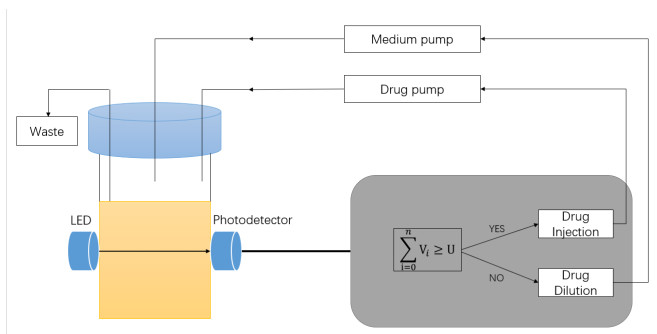









 DownLoad:
DownLoad:


